Best Way to Paint a Pebble Dash House
The Options for Rendering Explained – How to Paint the Exterior of your Home – Agreement the Options for Finishing Your Dwelling house's Outside with Rendering, Plastering and Painting
The options for rendering and finishing the outside of your habitation are many and varied. We aim to cover some of the near common exterior pigment and return finishes that are used on homes and so that you can sympathize the options that you accept, when yous should use them and how to maintain the finish on your home. We volition explain the types of render and finishes describing their advantages and disadvantages and then y'all have a expert understanding of your exterior finishing options.
By and large speaking the merely time that most people have to get involved with the external stop of their home is when they are conducting some form of repair or maintenance. While this is a very important job and a sound understanding of the finish that y'all are dealing with volition help, we believe that at that place is more to external finishes.
Due to the size of the boilerplate house any external alterations volition inevitably involve quite a bit of work, simply information technology is now possible to alter the look of your home dramatically with your choice of external finish, without it existence the monumental job it used to exist. Nosotros encourage people to exercise this if they have grown tired of the exterior of their habitation.
Having said this, it is important to ensure that you are not going to contravene any restrictions placed on properties that are listed or in conservation areas and councils exercise have powers to revoke your right to finish your home's exterior if it has received enough complaints. Come across below for exterior finishes that don't work!
Factors Affecting your Choices for Exterior Homes Finishes and Renders
There are a number of factors that volition bear on your options when it comes to choosing your exterior terminate. If y'all are aware of these you volition be able to make a more suitable option, but ultimately it comes downwards to your sense of taste and how your choice will work in the setting that your home is in. Some of the most important factors include:
- Existing Substrate – This is the textile that will exist nether the finish of your choice. This is peculiarly important when using a render as the return volition have to attach to this surface and move with it
- Age of the property – Non only volition this touch the ascetical setting, the substrate and the method of construction, information technology will also take a bearing on the amount of grooming, repair and ongoing maintenance that yous will likely accept to do to the exterior of your home
- Your desired colour and stop effect – Unless you are in a listed property, this is the cistron that should behave the most weight. You must ensure that your belongings is finished in a way that you notice bonny and is in keeping with it'southward environment. You don't want to autumn out with the neighbours
Homes are typically rendered because it is non possible to attain a suitably bonny and weatherproof stop with the rock or brick piece of work. Renders are also used when the exterior wall has been damaged and this is the cheapest way to brand it weatherproof again. In some cases it is possible to rectify and recover brick and stone work, so that is looks authentic and attractive, there are several products on the market place at current.
Broadly speaking there are three master types of outside finish that you can apply to your dwelling, and you lot may employ i of more on a unmarried property. These are the main types on cease:
- Painting
- Rendering
- Cladding
Inside these categories of exterior finish, there are numerous options available and we volition cover these main options next – cladding will be covered in a separate project.
Finishing a Dwelling house with Render
Within the category of rendered finishes to a abode, there are two distinct options; Traditional Renders and Special or Modernistic Finishes. They are much as they sound; the traditional renders are those that have been used on houses for a long time, some for hundreds of years with very piffling modify, and the more than modern ones are those that have been invented using new materials, techniques and technologies.
The term Stucco is often used to draw return, particularly in N America. This can be applied to all forms of render from lime renders and cement to more than modern types of return all of which we discuss here.
Stucco, thought to be of Germanic origin, was widely and nearly popularly used in Italian republic where mortars and renders were lime based, reinforced with horse hair and practical in several coats forming the bases of what is now known equally Venetian plastering.
The word Stucco has, over the years, been applied to almost every form of render only information technology is fair to say that originally it referred to the lime based pastes that were used, either in a smoothen cease or a textured coat, to provide an attractive finished surface on an otherwise evidently wall.
The central difference betwixt the plaster that y'all can use on the interior of your abode and the plaster or render that is used in the exterior is that the exterior render must be weather proof – It has to provide protection from the elements, especially driving rain and it should be able to withstand temperature changes and fluctuation of moisture levels that an interior plaster does not need to.
The Components of Renders
Renders are made upwardly of a variety of components, and the varying amounts volition determine the type of render and its backdrop and characteristics. The proper name of the render will reflect the proportions of these elective parts. The components of a return are:
- Binding Amanuensis: This is the compound that acts equally the adhesive and holds the return together providing its strength, moisture resistance and permeability. Typically it is cement, lime, clay or gypsum
- Structural Filler: This is the 'volume' that makes upward the majority of the plaster. Sand is the most common, but other aggregates are frequently used likewise
- H2o: Water is employ to piece of work the return and typically activates the binding agent
- Fibre: These can be added to the render to provide force and 'stretch', or tensile reinforcement and improved rubberband functioning. Traditionally this was horse hair, merely hemp, harbinger and reed fibres have been used. More commonly fibreglass fibres or a plastic (nylon) mesh is used nowadays and even steel fibres can exist used
- Additives: These are chemicals that are added to the mortar mix to change the characteristics of the render. Common additives include silicon, polymers and acrylic. These are added to change the backdrop of the render, particularly the workability, elasticity, immovability and the colour
The mixture of these component parts volition determine the backdrop of the render.
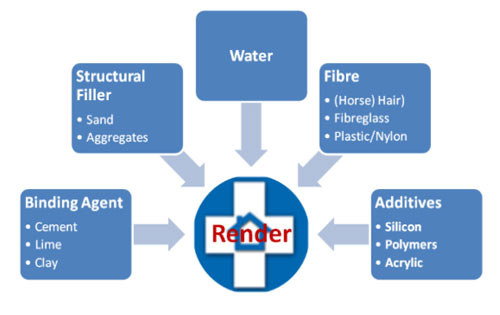
The components function of render: The mixture of these components will determine the properties of the render
Types of Traditional Render Finishes
The most common traditional render finishes include:
Lime Render
This is a render that is made with lime and it has the huge advantage of being both breathable and very flexible. This ways that it is particularly suited to edifice which experience a lot of motion, such as timber framed buildings and older, traditional buildings.
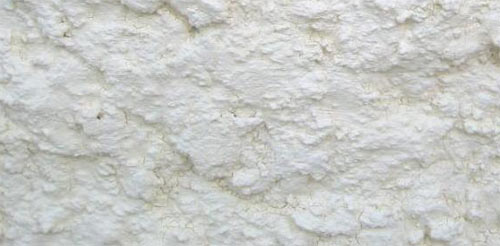
Lime return applied to an exterior wall – Image courtesy of www.theheritagedirectory.co.uk
Lime return is sometimes referred to as Traditional Natural Hydraulic Lime Render and has been traditionally applied to walls that accept been built out of low quality stone or rubble, porous bricks, or where walls are exposed to driving wind and rain. The lime render does not create a barrier for the moisture but acts like a sponge and absorbs the h2o, stopping it passing through the wall by 'sucking' it up. This moisture will then evaporate from the lime render into the outside air when the weather condition turns.
Because traditional buildings that have been lime rendered have the moisture removed from them in this way, they tin oft tend to experience penetrating damp when the lime render is removed or replaced with cement return.
To strengthen the return, chopped pilus was traditionally added and casein (an excerpt from cow'due south milk) tin can exist used equally a plasticiser on difficult substrates. It is also possible to colour lime render to a broad variety of colours and shades. Lime render is seen as an eco friendly product equally the curing process absorbs CO2 from the air every bit the render 'sets' to a limestone state.
There are a variety of ways that Lime render tin can be applied and these will exist determined in part by the substrate and in role past the stop required.
In traditional buildings the render might be applied in a single coat, over a very rough and uneven substrate. In this case the render is almost used equally very full flush pointing, with thick covering over the hollows and sparse or sometimes no return over the stones of the wall themselves. To create a smarter and flatter terminate more coats tin be added and worked into a flat, even surface.
Information technology is possible to use lime renders on a huge range of substrates including earth, stone, brick, timber framed buildings, stone or rubble filled walls, and straw bale walls. It can also be used on new builds that apply all sorts of blocks, bricks, metal and fibre boards. Information technology is very versatile as an external terminate, and can also be used on interior walls too.
The Pros and Cons of using Lime Render
| Pros of using Lime Render | Cons of Using Lime Render |
|
|
Notation that you should not confuse lime return with hydrated lime products which are used as a cement additive.
Sand and Cement Renders
These are renders that are typically made using Portland Cement (OPC – Old Portland Cement) and are much stronger and harder than whatsoever lime render. This type of render is typically painted.
Cement renders are non suitable for older buildings as the building construction tends to result in more movement which quickly causes dandy in the render. Additives (such equally hydrated lime) can be used in the cement to increase the flexibility and durability simply because this type of render is then hard it is e'er prone to cracking.
Like a lime render, cement renders are not waterproof so they are by and large finished with finishing coat, typically paint, for protective and decorative purposes. Cement renders have been traditionally mixed on site, but increasingly now it is possible to purchase pre-packaged renders. These take the advantages of ensuring that the return is consistent which will help to reduce swell, they are also easier to handle and can even be machine applied saving time and effort.
The huge advantages that a sand and cement render has is that they are cheap and they are besides quick and relatively easy to use. This makes them a popular choice, particularly in new build homes, where the movement is less and the substrates are firmer so reducing the propensity to cracking.
As a result of the potential for cracking there is more than maintenance generally required with a cement based render. If there is any motility in the substrate or any moisture build upwards in the render it will cause the finish, typically paint, to get damaged and peel or flake away.
The pro's and con'due south of using sand and cement render can be summed upwardly as follows:
| Pros of using Sand and Cement Return | Cons of using Sand and Cement Render |
|
|
Dirt Render
Clay was the very beginning material to be used in renders and plasters and it is making resurgence lately due to its environmental credentials; it is very easy to produce and can often be locally sourced, although to ensure that the you lot utilize a render with predictable and consequent qualities it is wise to source a commercial clay return. There is minimal processing with makes a dirt return much more environmentally friendly.
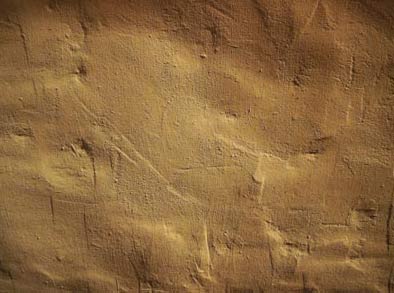
A rustic dirt render – Image courtesy of bristolgreenhouse.co.great britain
The characteristic that separates dirt renders from the culling cement or lime based renders is that it does not chemically cure (and therefore does non alter its chemic limerick always once information technology goes off). As a effect clay render can be re-activated past the addition of h2o, which ways that it tin be reworked; handy for repairs, just non and so helpful equally it volition erode abroad.
Dirt render will concenter water and hold it. This is helpful if information technology is used against a wooden or straw substrate, however this can also prove a serious limitation should it be used with a modernistic substrate.
Traditionally binders such equally straw can been added to the clay to improve its durability and resistance to erosion. To increase the 'h2o proof-ness' oils such equally linseed oil tin exist added to the dirt render. Adding an excessive amount of oil will reduce the water absorbency of the render and end the permeability, preventing it from 'animate'.
The Pros and Cons of using Dirt Return
| Pros of using Sand and Cement Return | Cons of using Sand and Cement Render |
|
|
Pebble Dash
Pebble dash does not specifically refer to the return but to the decorative terminate that is applied to it. The wet mortar is coated with pebbles (sometimes called Spar although spar includes pebbles, chipping's, shale and gravel) just the underlying mortar can vary.
Traditionally the mortar was a lime based, but it is more common at present for cement to be used. There has been a growing utilise of polymer cements more than recently just every type of mortar comes with diverse advantages or disadvantages over the other options.
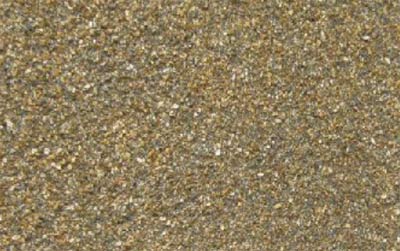
A pebble dashed wall
The pick of mortar for pebble dashing will dependant on similar factors to those that affect the selection of a render that in not going to be coated.
Lime renders will be used in traditional building which move more and demand the extra flexibility, or aesthetically it would look odd to annihilation merely the existing return. Cement can exist used where the substrate is suitable and the budget is limited. Polymer mortars can be used where a wider range of colours is required to increase the options for the spar (pebbles) that tin can be used.
When it comes to the dissimilar types of pebble nuance that are used, there are a few. In recent times the practice of pebble dashing has fallen out of favour and then none of these methods are used frequently any more than, just these are the more usually used:
- Wet Dash: Also known as roughcast. The chipping'southward or spar are mixed into the last coat of the mortar which is and then cast or sprayed on to the wall. This is one of the more traditional pebble dash type finished used in the United kingdom
- Tyrolean Render: Tyrolean return is applied using a Tyrolean Gun to build upwardly several layers. This is a cement based textured render which is ideal for covering old or poor brickwork. A Tyrolean Gun is a special saucepan with a spindle in the middle rather similar a hairbrush which tin can either be turned past hand or be powered
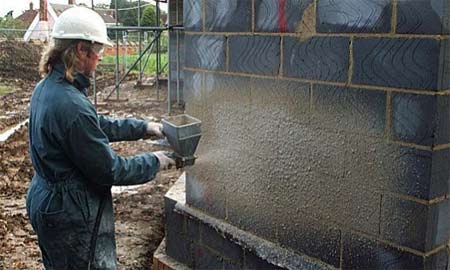
Using a Tyrolean gun to employ render – Image courtesy of neverpaintagain.co.uk

The Faithfull Flicker Hand Wall Coating Sprayer – available in our online store
- Harl or Harling: This is a traditional render that is usually institute in Scotland or Ireland. The harl is a mainly lime render so it cures rather than dries on the wall, is applied using a flicking method layering upwards until the desired result is achieved. While the render is still wet pebbles are thrown into it and then pressed lightly into the render
Recently there accept been technological advancements that have immune new compounds to exist used in renders. This allows you a wide range of finishes that have not been bachelor before. Alongside these, new techniques accept been developed that have altered the finishes that are available. Some of the nearly interesting are listed below.
Modern Polymer Return Finishes
These are cement based products into which specially developed polymers have been added to change to properties of the cement. There are two principle compounds that are used with polymer renders to improve their functioning and increase their usability.
- Silicon: Silicon has a h2o repelling property that tin exist used to drive h2o abroad from the surface of the render but while still allowing the render and wall to 'breath' and allow moisture pass through and out of the wall. Silicon water repellents are premixed into the cement or polymer render mix
- Nylon or Glass Fibre: Nylon and glass fibre is used in reinforced base of operations coats, which provides a actually strong base return before the cease coat is applied. A mesh, typically of nylon, is embedded into the base coat effectually the whole building. In some case this nylon base coat can be applied around stress points where smashing is likely, such as around windows and doors. The mesh is 'breathable' and quick to use and provides the strength needed
There are some polymer renders that practise non require a base of operations coat. They are called monocouche or i glaze renders. While they allow for quicker rendering at that place are limitations to the substrates that they can usually be practical to, typically only beingness used on lightweight or cakewalk blocks.
Modern Acrylic Render Finishes
Acrylic renders are finishing coat renders that are applied to achieve an attractive finish. Information technology can be applied to a prepared substrate or to a base coat render and in some cases, to the existing render and then long as information technology has been prepared properly.
These acrylic aggregates are added to the render mix to achieve an bonny terminate in the desired colour. They tin be sprayed on then applied with a float. Typically they volition be applied to a base glaze, just can also exist used on well prepared brick and stone work.
Spraystone Render Finishes
Spraystone are typically acrylic exterior finishes that tin can be practical to any surface including drinking glass and plastic (so you could fifty-fifty stop your pipe work to blend it with the render!) as they are highly flexible.
They are normally used for exterior finishes because they are breathable, like a porous paint, but they are low-cal and can look exactly like a rock finish such as marble to granite. This means they can exist used in places where a traditional stone finish would be too heavy or expensive, just they would produce exactly the same outcome.
This is a relatively new type of idea and cease (certainly in respect to the UK marketplace) so hither follows a little more than information on how it is practical:
Applying a Spraystone Finish
The substrate surfaces need to be carefully prepared and all windows and doors should exist masked:
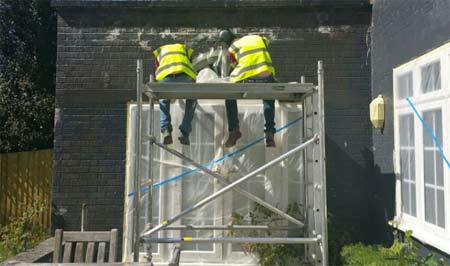
Preparing to spray outside walls with Spraystone acrylic paint
The prepared surface is then sprayed with a base of operations coat that acts every bit a primer and provides the color before the textured surface is applied.
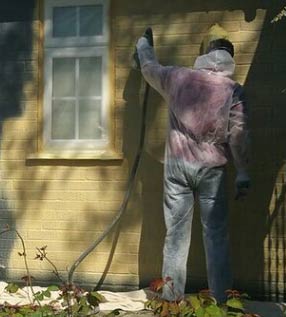
Spraying on the Sprayspone base glaze
Finally the textured surface coat is applied to create the desired effect. There are numerous effects that are bachelor, mimicking about all types of stone end, both smooth and textured.
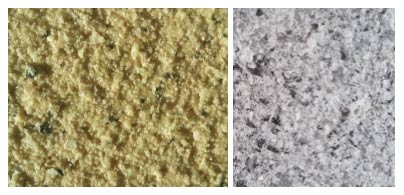
Sandstone and granite effect terminate using Spraystone acrylic paints
Benefits of a Spraystone Finish
The benefits of Spraystone are numerous; it is a highly flexible outside stop that can be applied to almost whatsoever surface (even an old umbrella has been sprayed to create a granite result!). It is also porous and breathable which means that it volition not create bug with damp and moisture memory. The finish is incredible realistic, yet much lighter than real stone, meaning there are a lot of different applications that are available.
On the other hand, it is not actually a DIY chore equally the awarding needs to exist done advisedly to ensure that the desired consequence is achieved. While spraying is a quick way to utilise the cease, information technology is vital that the preparation of the wall is thorough and any areas non to exist sprayed must be masked properly.
For more than information about applying less specialist return to the exterior of your home yourself, have a await at our project describing how to return outside walls using more traditional methods.
External Wall Insulation
With more and more than focus being put on saving energy, external wall insulation (EWI) is becoming a much discussed topic when exterior rendering is mentioned. By adding external wall insulation is it possible to reduce the heat that is lost from the building in cold conditions (and gain in warm weather).
It does not take upwards space within the building, as internal wall insulation does, so is seen as a popular option when there are no cavities to fill with insulation. It is possible to utilize external wall insulation on a wall with a crenel, particularly if in that location is some reason that information technology is inappropriate to add insulation to the cavity.
Earlier the return is applied an 'insulant' is fixed to the wall, either with an agglutinative or with fixings such equally dowels and screws. The choice of insulant volition depend of the level of insulation required, the thickness that is needed and your budget.
In some case it is necessary to extend the eves and overhangs to cater to the extra thickness being added to the walls.
The insulant or insulation is typically added in the form of boards or sheets, over which the return and finishing are applied. It is the render that provides the weather proofing and decorative covering.
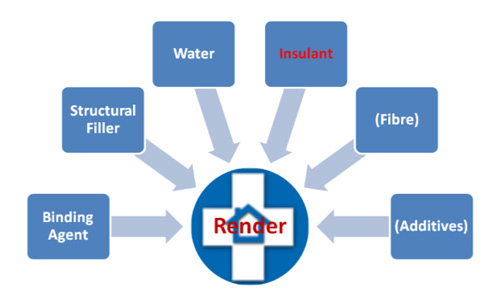
Insulant added to the external walls along with return
Painting Exterior Walls on Your Habitation
Repainting your home or painting the return is a fantastic mode to amend the await of the property relatively cheaply. It is an ideal DIY chore say if you lot are getting ready to sell, or simply want to bandbox the identify upwards a little bit.
Generally there are no restrictions on painting a house as this is deemed a permitted development, nevertheless in some cases restrictions apply. If the business firm is listed the colour and way will be stipulated, if you live in a conservation area or National Park there tin exist restrictions and flats do not have permitted developments. If you do non own the freehold, you should check with the freeholder every bit they might take applied some restrictions.
Preparation for Painting Outside Walls
The surface needs to be prepared before you lot paint. Information technology must exist stable and any blown brickwork or return volition take to be repaired before you starting time. Prepare your wall for painting with these steps:
- Brush down the walls with a wire brush to remove whatsoever loose mortar, moss or mould. This should be easier if you lot have newly rendered the walls, only they will notwithstanding need some preparation. All surface dirt, loose fabric or paint should be removed
- Fill all cracks with a suitable filler or return mix; the pick will depend of the render that has been used on the walls. For small cracks y'all can do this in i go with a filling knife which you lot can utilise to smooth off the surface. If the cracks are deeper than around 10mm then y'all should build upwards the filler in layers, allowing fourth dimension for each layer to dry before applying the next layer. Once the filler has dried in the cracks it should exist sanded dorsum downwards then that it is smooth. If at that place are cracks that are sufficiently big or structural yous should alert your building's insurer
- Mask up the doors, windows and pipe work so that it doesn't become covered accidentally while y'all're painting the walls
- Priming the walls with a breathable primer is an important step. This is particularly important on porous and powdery surfaces then that you create a good surface for the paint to exist applied. A breathable primer is necessary to ensure that the wet in or coming through the wall and it's return are allowed to escape. This is particularly important in solid walls as there is no cavity for this wet to escape into.
How to Pigment your Exterior Walls
Before you start any painting it is of import to think about using ladders and safe while working at height. Delight see our project on ladder condom here.
In that location are relatively few restrictions to the selection of paint that y'all are allowed, simply it is of import to ensure that the pigment that you do select is breathable, which will not trap moisture underneath it inside the wall or the return. If the wall has been painted with an impermeable paint, and you are experiencing damp you will need to strip the walls earlier yous apply a breathable paint.
As a full general rule, textured paints are good for smooth renders, and a smooth pigment is easier to apply to a rough surface, such every bit pebble-dash or Harling.
Steps for painting an exterior wall
- Check the weather forecast; you volition need clear dry days in social club to go the walls painted, so make sure that yous have plenty forecast so that you lot can become the whole chore done in one go
- Dissever the wall into manageable sections which you feel that you can complete in one session. Use features like downpipes and windows to guide y'all
- Lay out ground sheets and mask pipe piece of work with newspaper before you showtime
- Get the right equipment:
- Masonry Brush – for cut in and applying paint to areas the roller tin can't reach
- Masonry roller – for tackling whatever big, flat areas with ease
- Extension pole – for attaching to roller to reach college areas
- Paint kettle – for filling with paint to save on trying to hold large pigment tins and containers
- Ladder or platform – for safely reaching higher area
- Offset at the top of the wall and piece of work down so that you are non splattering newly painted wall
- Utilize horizontal or vertical strokes to apply the paint. Apply the fully loaded brush to an unpainted part of the wall and and so piece of work back to the last painted function. Work over the painted surface in a diverseness of directions then that yous get a expert coverage and ensure that the surface is completely covered, peculiarly on a rough surface
- Stipple with the bush-league; on a rough surface the only way that y'all will be able to go the paint in to the texture of the wall is to hold information technology at right angles to the wall and so button the beard, and paint, into the wall.
- Cut around downpipes and vent pipes. Ensure that you carefully pigment behind the pipes with a castor
Dispose of whatsoever backlog paint according to their instructions. Run into you local council website for how to dispose of paint correctly.
Outside Finishes that Don't Work
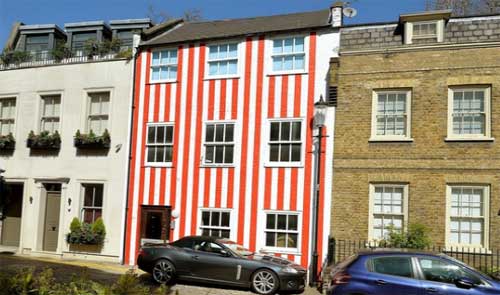
An exterior finish too far – A developer painted candy stripes on this firm to annoy neighbours after they objected to a planning application – Image courtesy of the Guardian
This candy stripped end was ordered to be repainted after numerous complaints and mass coverage in the media. Kensington and Chelsea Council used section 215 under the Town and Country Human activity, commonly invoked when a property'due south "condition adversely affects the assiduities of the surface area".
Here are some more examples that are not regarded as hugely tasteful:
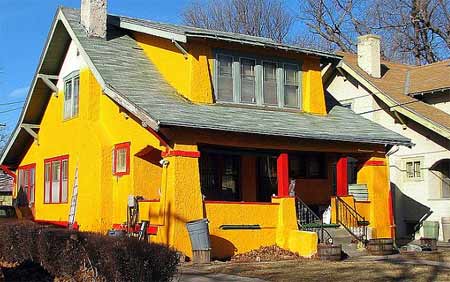
Interesting outside paint choices – Prototype courtesy of charlesandhudson.com
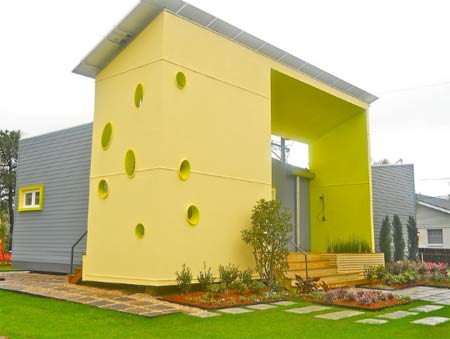
Contemporary color scheme – Image courtesy of jetsongreen.com
Irresolute your Abode with External Finishes
There are numerous options available to the homeowner to ameliorate their abode with render and paint. Modern products have made it all the easier to achieve a dramatic finish without having to spend a small fortune. Improving your dwelling's exterior is a challenging but a very worthwhile projection.
campbellblipt1987.blogspot.com
Source: https://www.diydoctor.org.uk/projects/rendering-and-exterior-finishes.htm
0 Response to "Best Way to Paint a Pebble Dash House"
Post a Comment